This is a sponsored piece courtesy of ChessOpenings24-7.com. Details of their exciting promotion are at the end of the article.
Successful opening preparation essentially depends on two key components: reliable opening repertoire, and/or the ability to surprise the opponent. Many chess players are aware of that fact, but, in order to achieve their goal, time must be invested studying openings from a source that can be trusted, be it an expert, book, or software.
WGM Sanja Vuksanovic, the founder of Chess Openings 24/7:
“I firmly believe that it shouldn’t matter whether you come from a nation with rich chess tradition where knowledge and information is readily available; money for expensive coaching sessions mustn’t be a decisive factor; you shouldn’t waste endless hours gathering information just to end up analyzing each move with chess engines – you need a place where everyone should be starting equal. This is why we made the Chess Openings 24/7 online service: a chess opening database for all chess enthusiasts – professionals or amateurs.”
GM Boris Avrukh, Editor-in-Chief:
Assembling the Chess Openings 24/7 Editorial Board (Boris Avrukh, Vadim Zvjaginsev, Bojan Vuckovic, Borki Predojevic, Dragan Šolak, Aleksandar Kovacevic, Dragan Barlov, Dragan Paunovic, Slaviša Brenjo and Trajko Nedev) was an especially challenging task: all these grandmasters had to be expert in opening theory, yet also with advanced computer skills, to meet the necessary technical requirements. Their mental stamina had to be off the charts to overcome fatigue, and often frustratingly complex working procedure. Chess professionals are known to have very busy schedules, so everything had to be meticulously planned, well in advance. To build a cohesive unit wherein everyone is considered almost a family member, we needed to rely on fundamentally good people with great moral qualities.
often frustratingly complex working procedure. Chess professionals are known to have very busy schedules, so everything had to be meticulously planned, well in advance. To build a cohesive unit wherein everyone is considered almost a family member, we needed to rely on fundamentally good people with great moral qualities.
GM Bojan Vuckovic, the main architect of the CHOPIN code and classification system:
Our entire concept is based upon the assumption that top-level games are the most relevant for opening theory, so we practically took all available games wherein the opponents had an average rating of 2600 or above, and used them as the basis of our research. About 70,000 games were subjected to deep engine analysis, and numerous improvements and game fragments from our extensive reference database of 14 million over-the-board, correspondence, and engine games were recommended and added by our silicon friends.
Computer engines have, nowadays, become irreplaceable assistants in any serious chess analysis, yet their games are conspicuously absent from most opening books and articles. After thorough research, Chess Openings 24/7 is determined not to make that mistake, and engine games will have the same treatment as any other game. Such an unbiased approach is bound to reap instant rewards, and an example of it can be seen in the recently published “Pick of the Week” by GM Boris Avrukh:
Pick of the Week by GM Boris Avrukh
Adapted from the original article published on December 8, 2013
Ruy Lopez: The Anti-Marshall with 11. Bg5 [Line 395/C88]
1. e4 e5 2. Nf3 Nc6 3. Bb5 a6 4. Ba4 Nf6 5. 0–0 Be7 6. Re1 b5 7. Bb3 0–0 8. a4 b4 9. d4 d6 10. dxe5 dxe5
This has been a fashionable line among top grandmasters in recent years, and GM Avrukh's article focuses mostly on the theoretical outcome of the game between Anish Giri and Levon Aronian, from the recently finished World Teams Championship in Antalya.
11. Bg5!? h6
Aronian chose 11... Qxd1 in the above mentioned game, and it definitely seems more prudent.
12. Bxf6 Bxf6 13. Bd5 Qd6 14. Nbd2 Be6 15. Nc4 Qc5 16. Bxe6 fxe6 17. b3 Nd4
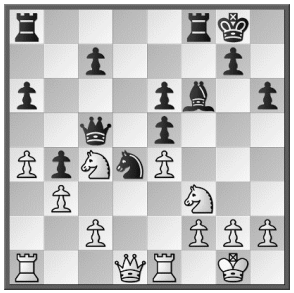
18. Rf1!!
This incredible prophylactic move prepares the topical Ne1-d3 maneuver and overprotects the f2 pawn at the same time.
18... Rae8 19. Ne1 Qc6 20. f3 Rd8 21. Nd3 a5
It's hard to believe that his subtle positional play is the “brainchild” of Stockfish 4, the notorious tactical monster. We've been following a recent (as of August 23, 2013) top-tier engine game Stockfish 4 – Naum 4.2, Internet 2013, and now White could have played
22. Rf2!
with a lasting pressure, due to Black's weak pawn structure. It seems that White can increase his advantage with accurate play.
Open
Opening Survey by GM Vadim Zvjaginsev
Adapted from the original article published on May 10, 2013
Two Knights Defense with 8. Bd3 [Line 367/C58]
1. e4 e5 2. Nf3 Nc6 3. Bc4 Nf6 4. Ng5 d5 5. exd5 Na5 6. Bb5+ c6 7. dxc6 bxc6 8. Bd3
GM Zvjaginsev claimed in his original text that many fine players had occasionally dabbled in the Two Knights Defense, as it offered a welcome repose from the uber-demanding Ruy Lopez, yet the example that you're about to see is almost the exact opposite. It seems that Vadim, as an exceptionally gifted and creative player, actually enjoys complications to such an extent that he finds them almost relaxing.
8... h6
Probably not the best; immediate 8... Nd5 seems more to the point.
9. Ne4 Nd5 10. 0-0 g6 11. Re1 f5 12. Nbc3!
We've been following the game S. Nilsson – T. Sakelšek, Rogaška Slatina 2011, and now we'll examine
12... Rb8,
which is aimed against 13. Nxd5 cxd5 14. Bb5+.
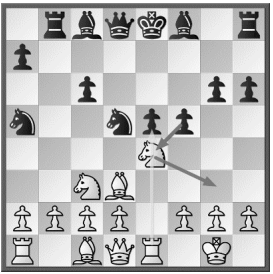
13. b3!!
Vintage Vadim! White is completely unfazed by the threat against his knight, and calmly continues with his development.
13... fxe4
What else? 13... Bg7 is met by 14. Ba3!
14. Bxe4 Qd6 15. Bb2 Ne7
15... Bg7 is met by 16. d4! Ne7 17. Bd3!, and after 17... 0-0 18. dxe5 Qc7 19. Qd2 Black pieces are left in complete disarray.
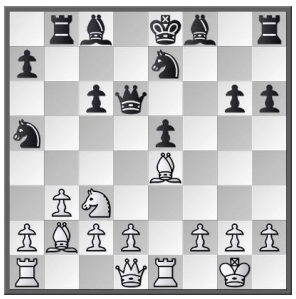
16. Nd5!!
Come again?
16... cxd5
Refraining from the capture is hardly better: 16... Bg7 17. Nxe7 Kxe7 18. Qe2, and Black king is stuck in the center, where threats like d4 or f4 loom around every corner. White has ample compensation for the sacrificed piece.
17. Bxe5!
It's become pretty obvious that the writing is on the wall for Black, and White gives him no quarter.
17... Qxe5 18. Bxg6+! Nxg6 19. Qh5!
The calm before the storm – White has sacrificed all his minor pieces, and is now ready to harvest the material with dividends.
19... Bg7 20. Rxe5+ Bxe5 21. Re1 Kf7 22. Rxe5 Nc6 23. Rxd5
Black pieces are hopelessly uncoordinated. White has a lasting initiative.
Opening Survey by GM Borki Predojevic
Adapted from the original article published on January 4, 2014
Philidor Defense, The Exchange Variation with 7. Be3 [Line 295/B07]
1. e4 d6 2. d4 Nf6 3. Nc3 e5 4. dxe5 dxe5 5. Qxd8+ Kxd8 6. Nf3 Bd6 7. Be3!?
A) June 29, 2013
Our editor GM Borki Predojevic suffers at the hands of Magnus Carlsen, the undisputed World No. 1, in the fourth game of their rapid match in Lillehammer:
7... Nbd7 8. 0-0-0 a6 9. Bc4
9. Nd2 is also very promising for White; see R. Hovhannisyan – A. Nadanian, Jermuk 2011.
9... Ke8?!
Placing the king on e7 was a much better option.
10. a4 h6 11. h3 b6
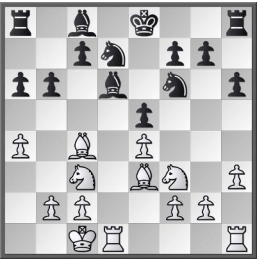
12. Nd2!
Aiming for c4.
12... Bb7 13. f3 Ke7 14. Bb3 c6 15. Nc4 Bc7 16. Bf2 b5 17. Ne3 g6
18. Ng4!
Suggested improvement for White, with the idea 19. Bh4.
18... Rad8 19. Bh4 g5 20. Bf2 Nxg4 21. hxg4
and White has a lasting advantage.
B) December 18, 2013
Borki employs the World Champion's set-up against GM Aleksandar Indic, the No. 1 Serbian junior and a member of the national team, and reaps rewards from the lesson learnt.
7... a6 8. 0-0-0 Ke7 9. Bg5! Be6
Another possibility is 9... c6, with the following examples from correspondence play: 10. Bc4 Bc7 11. Nh4! (11. Be3 Nbd7 12. h3 b5 13. Bd3 Rd8 with mutual play, A. Oleksak – V. Ivanov, corr. 2012) h6 12. Nf5+ Bxf5 13. Bxf6+ Kxf6 14. exf5 Rf8 15. g4 Ke7 16. h4, when White had a moderate kingside control advantage and a lasting initiative in T. Hagen – J. Johansen, corr. 2011.
10. Nh4! g6?!
Black should have tried 10... Nbd7, though White could still obtain a tangible pull after 11. Nf5+ Bxf5 12. exf5.
11. Nf5+!
Still! This temporary sacrifice gives White the advantage.
11... gxf5 12. exf5 Rg8 13. Bxf6+ Kxf6 14. fxe6 fxe6 15. Bd3
and White had the upper hand in B. Predojevic – A. Indic, Zadar 2013.
Opening Line 449 by GM Bojan Vuckovic
Adapted from the original text published on November 19,2013
The Paulsen Sicillian, Taimanov-Bastrikov Variation without 5. Nc3 [Line 449/B44]
1. e4 c5 2. Nf3 e6 3. d4 cxd4 4. Nxd4 Nc6 5. Nb5 d6 6. Bf4 e5 7. Be3 Nf6 8. Bg5 Be6 9. Nd2 Be7 10. Bxf6 Bxf6 11. Nc4 0-0 12. Qxd6 Qc8!? 13. c3 Bxc4 14. Bxc4
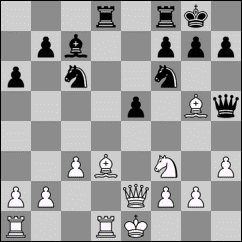
14... Nd4!
An important novelty suggested by GM Vuckovic. Black's previous tries (14... Qg4, J. Nunn – M. Tal, Reykjavik 1988, and 14... a6, V. Peresipkin – G. Timošcenko, USSR 1973) appear to fail to equalize.
 15. Na3 15. Na3
Accepting the sacrifice is dubious at best: 15. cxd4?! Qxc4 16. Qc5 Rfc8 17. Qxc4 Rxc4 18. b3 Rb4 19. Nd6 Rxd4 20. Nxb7 Rxe4+ 21. Kf1 a5, and Black is slightly better.
15... b5! 16. Bxb5
Capturing the knight is still wrong: 16. cxd4?! bxc4 17. d5 c3 18. b3 Qg4 19. 0-0 Qxe4, and Black is again a bit better.
16... Nxb5 17. Nxb5 Rb8 18. Nxa7 Qb7
18... Qc4 is also good: 19. Qc6 Rfc8! 20. Qxc4 Rxc4 21. Ke2 This move leads to perpetual check. 21... Rxb2+ 22. Kd3 Rc7 23. Rhb1 Black has a back-rank weakness. 23... Rd7+ 24. Kc4 Rc7+ 25. Kd3 Rd7+.
19. Nc6 Rfd8! 20. Nxd8 Qxe4+ 21. Kf1 Rxb2
Black has sufficient compensation for the sacrificed material.
22. Re1 Qc2 23. Qd4!
A neat defensive resource: 23... exd4?? would end up in mate after 24. Re8#.
23... h6 24. Qe3 Bxd8 25. Qf3 Rxa2 26. g3 Bb6 27. Rxe5 Qa4 28. Kg2 Rxf2+ 29. Qxf2 Bxf2 30. Kxf2 Qc2+ 31. Re2 Qxc3=. |